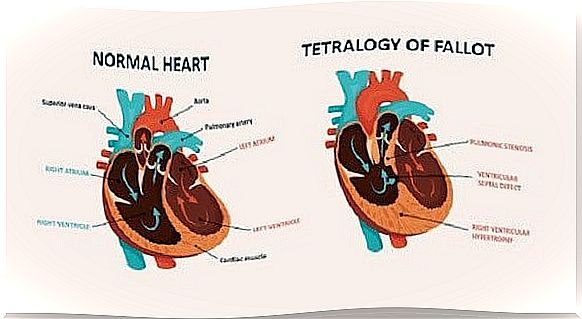What Is Tetralogy Of Fallot?
Tetralogy of Fallot is a congenital heart disease that requires early correction. Let’s see in depth what symptoms and problems this disease presents.

Tetralogy of Fallot is a fairly common congenital heart disease that needs early intervention so that it does not affect the life of the patient. Throughout this article we will discover what symptoms it presents, complications and treatment possibilities.
As the article Tetralogy of Fallot in the adult patient points out. Speaking of one case , this disease constitutes 10% of all congenital heart disease. Its early intervention is necessary as it can cause serious complications and affect the quality of life of patients.
Tetralogy of Fallot
Tetralogy of Fallot is characterized by presenting infundibular stenosis of the pulmonary artery, as indicated by Tetralogy of Fallot: a case report and literature review . This is: the muscle under the valve is thicker and causes a narrowing at the outlet of the right ventricle.
Likewise, this congenital heart disease can also present with aortic thrust. This means that the aorta rests on the VSD and prevents its proper function.

Similarly, another characteristic of Tetralogy of Fallot is that it can manifest hypertrophy of the right ventricle. The heart muscle thickens, causing it to have to work harder to contract due to the narrowing of the ventricular outlet.
Symptoms
The reason why tetralogy of Fallot should be operated on as soon as possible is because its symptoms are severe. In fact, we are going to see some points that will allow us to know a little better how it affects the quality of life of younger patients:
- Cyanosis : the skin and mucous membranes have a bluish coloration that indicates that there is poor oxygenation of the blood. They can appear on the face, hands or anywhere else on the body, and also in the mouth (perioral cyanosis).
- Diaphoresis : sweating that occurs when the baby is breastfed, because it involves a great effort and it is difficult for him to breathe (dyspnea).
- Acrocyanosis : the fingers and toes are characterized by being cold most of the time. They present cyanosis and diaphoresis.
Children can also have a heart murmur. Likewise, the delay in its development, the presence of fatigue due to the minimum performance of physical exercise and, even, fainting can warn of the presence of this congenital heart disease.
Complications

It is necessary to raise awareness about the importance of treating tetralogy of Fallot as soon as possible. In fact, all children with this heart disease must undergo corrective surgery.
Without treatment, this heart disease can lead to death at an early age. It can also lead to disabilities in adulthood. Also, failure to treat this congenital heart disease can lead to infections. For example, inflammation of a heart valve due to a bacterial infection.
Living with tetralogy of Fallot
A person who undergoes surgery early to treat Tetralogy of Fallot can lead a normal life. However, lifelong medical monitoring is necessary due to certain risks.
People who have been treated for this congenital heart disease are at risk of sudden death after the age of 35, although the percentage is very low. Also, arrhythmias can increase over the years.
Pregnant women with this pathology must undergo certain tests that assess their health, the arrhythmias they have and the measures they must adopt (absolute rest, no harmful habits such as smoking, healthy weight …).
As we have seen, being born with tetralogy of Fallot can condition the rest of our lives. However, with early corrective surgery and medical follow-up, a completely normal quality of life can be achieved.
We hope that this article has allowed you to know a type of heart disease that you may not have heard about until now. This will help you take the necessary measures if someone in your environment suffers from it at some point.









